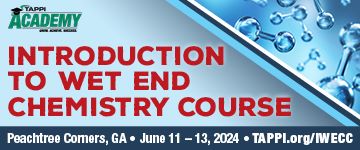 Search
Search
Use the search bar or filters below to find any TAPPI product or publication.
Filters
Publications
Level of Knowledge
Collections
Journal articles

Magazine articles

TAPPI Journal Summaries, Paper360º May/June 2021
TAPPI Journal Summaries, Paper360º May/June 2021
Journal articles

Magazine articles

Editorial: TAPPI Journal 2019 Best Research Paper addresses hard scale formation in green liquor pipelines, TAPPI Journal March 2020
ABSTRACT: TAPPI and the TAPPI Journal (TJ) Editorial Board would like congratulate the authors of the 2019 TAPPI Journal Best Research Paper Award: Alisha Giglio, Vladimiros Papangelakis, and Honghi Tran. Their paper, “The solubility of calcium carbonate in green liquor handling systems,” appeared on p. 595 of the October 2019 issue. This kraft recovery cycle research was recognized by the TJ Editorial Board for its innovation, creativity, scientific merit, and clear expression of ideas.
Journal articles

Magazine articles

Corrosion damage and in-service inspection of retractable sootblower lances in recovery boilers, TAPPI Journal October 2021
ABSTRACT: Several reports of accidents involving serious mechanical failures of sootblower lances in chemical recovery boilers are known in the pulp and paper industry. These accidents mainly consisted of detachment and ejection of the lance tip, or even of the entire lance, to the inside of the furnace, towards the opposite wall. At least one of these cases known to the author resulted in a smelt-water explosion in the boiler.In other events, appreciable damage or near-miss conditions have already been experienced. The risk of catastrophic consequences of the eventual detachment of the lance tip or the complete lance of a recovery boiler soot-blower has caught the attention of manufacturers, who have adjusted their quality procedures, but this risk also needs to be carefully considered by the technical staff at pulp mills and in industry committees.This paper briefly describes the failure mechanisms that prevailed in past accidents, while recommending inspection and quality control policies to be applied in order to prevent further occurrences of these dangerous and costly component failures. Digital radiography, in conjunction with other well known inspection techniques, appears to be an effective means to ensure the integrity of sootblower lances in chemical recovery boilers used in the pulp and paper industry.
Journal articles

Magazine articles

Displacement washing of softwood pulp cooked to various levels of residual lignin content, TAPPI Journal September 2021
ABSTRACT: This study investigates the influence of the degree of delignification of kraft spruce pulp cooked at seven different kappa numbers, ranging from 18.1 to 50.1, on the efficiency of displacement washing under laboratory conditions. Although the pulp bed is a polydispersive and heterogeneous system, the correlation dependence of the wash yield and bed efficiency on the Péclet number and the kappa number of the pulp showed that washing efficiency increased not only with an increasing Péclet number, but also with an increasing kappa number. The linear dependence between the mean residence time of the solute lignin in the bed and the space time, which reflects the residence time of the wash liquid in the pulp bed, was found for all levels of the kappa number. Washing also reduced the kappa number and the residual lignin content in the pulp fibers.
Journal articles

Magazine articles

´We Must Grow—In All Areas’, Paper360º May/June 2020
´We Must Grow—In All Areas’, Paper360º May/June 2020
Journal articles

Magazine articles

Considerations in managing wastewater odor at pulp and paper operations, TAPPI Journal March 2022
ABSTRACT: Many pulp and paper mills are, at least periodically, faced with the release of odors that can migrate offsite and be considered a nuisance by nearby residents. At chemical pulp mills, perceptible odors associated with reduced sulfur compounds (RSCs) are common, many of which are highly perceptible owing to their low odor thresholds. As releases of RSCs and other odorous substances from production processes are progressively controlled, the proportional contribution from wastewater treatment systems to areal odors can increase. This review paper summarizes important fundamentals of odor generation, source identification, and control. Common odorous substances are identified, and mechanisms for their generation are summarized. Approaches for measuring odorous substances are detailed to enable more effective management, and various odor control strategies are discussed.
Journal articles

Magazine articles

Rise of the Machines, Paper360º March/April 2022
Rise of the Machines, Paper360º March/April 2022
Journal articles

Magazine articles

Best Practices for Wastewater Treatment and Management, Pape
Best Practices for Wastewater Treatment and Management, Paper360º November/December 2016
Journal articles

Magazine articles

Comparing a linear transfer function-noise model and a neural network to model boiler bank fouling in a kraft recovery boiler, TAPPI Journal, July 2024
ABSTRACT: Boiler bank fouling reduces heat transfer efficiency in kraft recovery boilers. Here, we model the relationships between boiler parameters and boiler bank pressure drop, an indicator of fouling, based on recovery boiler operating data. We compared two models: an autoregressive integrated exogenous (ARIX) model and a feedforward neural network. The ARIX model better simulates boiler bank pressure drop compared to the neural network (R2 of 0.64 vs. 0.58). Based on the ARIX model, we identified six boiler parameters that significantly influence boiler bank fouling and their relative contributions. Finally, we demonstrate how the models can simulate boiler bank pressure drop given artificial perturbations in boiler parameters.
Journal articles

Magazine articles

Mitigating Malodors at Pulp and Paper Production Plants, Paper360º July/August 2024






